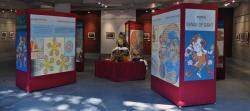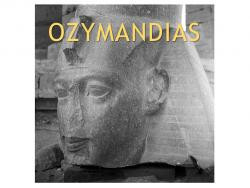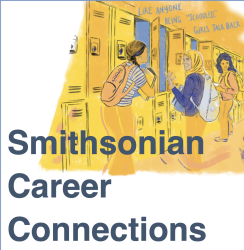Tracie Spinale
Learning Programs Manager
Smithsonian Institution
Middle School (13 to 15 years old), High School (16 to 18 years old), Post-Secondary
Teacher/Educator, Curriculum Coordinator, Parent, Museum Staff
Language Arts And English, Science, Social Studies, Arts, Special Education, Career and Tech Ed, Other
: Museum Studies
Hi there! I am the Learning Programs Manager at the Office of the Under Secretary for Education (OUSE) where I focus on positive youth development programs.
Enjoy!
- Positive Youth Development
- 4-H & 4-H Guide to the Smithsonian booklet
- Boys & Girls Clubs of America
- All Access Digital Arts Program - Collections for teens and youth with cognitive differences
- Distance Learning Resources
- A cultural science series from the Smithsonian Arctic Studies Center in Alaska (#arcticstudies)
- Maker and activity collections about environmental and social justice issues
- Topical collections
- A series on the intersection of Buddhism and Western Science
Tracie Spinale's collections
Representation of Girls - Gender Diversity, Empowerment and Stereotypes
<p>This topical collection looks at girls' diversity and empowerment, as well as gender stereotypes. Examples below are depictions of girls--both antiquated and modern--domestic and career expectations, educational opportunities, personal grooming and beauty, emotions and attitudes, and traditional representations.</p><p><br>How have views of girlhood changed over time? What images evoke strength and empowerment? What are some stereotypes? What is still true of girlhood today?</p>
 Tracie Spinale
Tracie Spinale
96
SENSES SERIES
<p>Aggregate of Learning Lab collections about the Smithsonian collaboration with the Science for Monks and Nuns Program - senses and sensory perception.<br /></p>
 Tracie Spinale
Tracie Spinale
11
Senses Series - Hearing
<p>How do we hear what we hear? This collection is about hearing the world in unexpected ways through human perspectives of science and culture, and animal adaptations. Meet a shark whose entire body is an ear; zoo otters who play the keyboard; rabbits whose large ear adaptations provide self-defense; and the reasons for a sea lion's bark. Learn about the structure and function of human ears can only see a certain type of light within the electromagnetic spectrum. Background information from the website Neuroscience for Kids provides an overview of how the ear and hearing functions work, as well as a sound experiments to try. The collections closes with a cross-cultural examination of hearing and function from Tibetan Buddhist monastics.<br /><br />Based on exhibition project work through <a href="http://scienceformonks.org/">Science for Monks</a> and <a href="http://scienceformonks.org/world-of-your-senses-web-tour/" target="_blank">The World of Your Senses</a> Exhibition (2010).</p>
 Tracie Spinale
Tracie Spinale
10
Senses Series - Touch
<p>How do we experience the sense of touch? This collection explores the variety of human and animal touch experiences. From the characteristics of a variety of objects, to a video which examines the touch experience of tortoises and pandas... we all experience touch differently. Background information from the website Neuroscience for Kids provides touch experiments; an examination of pain and why it hurts, and the functionality of the body's largest organ—the skin. The collection concludes with a cross-cultural examination of touch from Tibetan monks' Buddhist perspective. How might their experience of touch differ from your own?<br /><br />Based on exhibition project work through <a href="http://scienceformonks.org/">Science for Monks</a> and <a href="http://scienceformonks.org/world-of-your-senses-web-tour/" target="_blank">The World of Your Senses</a> Exhibition (2010).<span class="apple-converted-space"></span></p>
 Tracie Spinale
Tracie Spinale
19
Shelley's "Ozymandias" Poem: Museum Objects and Inspired Art
<p>How have museum objects and antiquities inspired arts and literature? Read and listen to a famous poem written two hundred years ago by English author Percy Bysshe Shelley, "Ozymandias." Then, view artworks which in turn were inspired by the poem. View the environmental landscapes and settings in ancient Egypt which inspired the original poem about the colossal sculpture of a famous ruler from over three thousand years ago. The collection concludes with a link to view a draft of the poem. Will Shelley's work inspire the creation of your own poem or artwork about a place you've traveled, or an object you've seen in a museum?</p>
<p>For a hand's-on paper-craft activity for younger students, visit <a href="https://learninglab.si.edu/q/ll-c/8MmERhz4keCesAxN"><strong>Nile, Nile Crocodile</strong></a> collection</p>
<p>keywords: sonnet, Ancient Egypt, Rameses II, Thebes, impermanence, cultural patrimony, distance learning, poetry, object-based learning</p>
 Tracie Spinale
Tracie Spinale
23
Smithsonian Career Connections
<p>Check out the wide variety of careers available at the Smithsonian and Smithsonian-adjacent fields. From Art to Zoology and everything in-between--if you have a passion and interest--there's a STEAM career for you!</p>
 Tracie Spinale
Tracie Spinale
88










